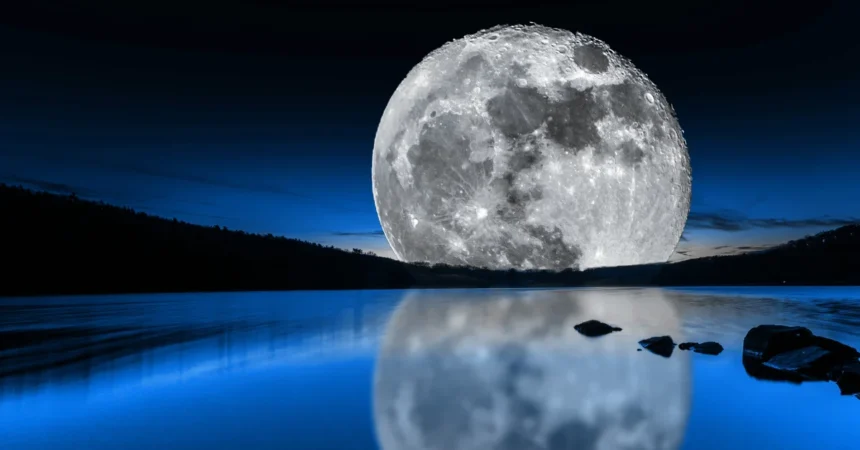Introduction
Tonight, the skies above Pakistan will treat stargazers and astronomy enthusiasts to a rare and breathtaking celestial event—the third supermoon of the year. This astronomical phenomenon has captured the imaginations of people around the world, and tonight’s supermoon promises to be one of the most memorable yet. Supermoons occur when the moon reaches its closest point to Earth, making it appear larger and brighter than usual. As the moon looms in the night sky, it provides a unique opportunity for onlookers to witness one of nature’s most awe-inspiring sights.
In 2024, this marks the third supermoon event, offering yet another chance to marvel at the wonders of our universe. The allure of supermoons isn’t limited to casual skywatchers; scientists, photographers, and astrologers alike eagerly anticipate these rare occurrences. In this article, we’ll delve into the science behind supermoons, explore their cultural and astrological significance, and provide tips on how best to observe this extraordinary spectacle in Pakistan. Whether you’re an avid astronomer or just curious about the night sky, this guide will help you make the most of tonight’s supermoon.
What is a Supermoon?
A supermoon is a full moon that coincides with the moon’s closest approach to Earth in its elliptical orbit, known as perigee. As a result, the moon appears up to 14% larger and 30% brighter than when it’s at its farthest point, called apogee. This phenomenon occurs because the moon’s orbit around Earth is not a perfect circle, but rather an elongated ellipse. When a full moon coincides with perigee, the increased proximity to Earth enhances its visual impact, making it appear unusually large and bright in the sky.
The term “supermoon” was coined in 1979 by astrologer Richard Nolle, though the phenomenon has been known and observed by various cultures for centuries. Scientifically, the correct term for a supermoon is a “perigean full moon,” but the more popular term has taken hold due to its catchy nature and widespread use in media. Supermoons typically occur three to four times a year, making them rare but not exceedingly uncommon. However, each supermoon can vary in size and brightness depending on the moon’s exact distance from Earth during the event.
The Science Behind the Supermoon
To understand the supermoon, it’s important to grasp the basic dynamics of the moon’s orbit around Earth. The moon takes approximately 27.3 days to complete one orbit around our planet, and its path is elliptical rather than circular. This elliptical orbit means that the distance between the Earth and the moon varies throughout the month. The moon’s closest point to Earth, or perigee, is about 356,500 kilometers (221,500 miles) away, while its farthest point, apogee, is about 406,700 kilometers (252,000 miles) away.
When the full moon occurs during perigee, the moon is significantly closer to Earth, which is why it appears larger and more luminous. The increased proximity amplifies the moon’s reflection of sunlight, making it appear up to 30% brighter than a regular full moon. This added brightness, coupled with the larger apparent size, is what gives the supermoon its distinctive and dramatic appearance. The effects are particularly noticeable when the moon is close to the horizon, as the “moon illusion” can make it seem even bigger than it actually is.
How Often Do Supermoons Occur?
Supermoons occur relatively frequently, but the conditions that make each one special vary from year to year. In 2024, skywatchers have already had the opportunity to witness two supermoons, with tonight’s being the third. On average, supermoons occur about three to four times a year, though their timing depends on the moon’s orbit and the alignment of the full moon with perigee.
Not all supermoons are created equal, however. Some supermoons are closer to Earth than others, and these are often referred to as “extreme supermoons.” Extreme supermoons occur when the full moon coincides with perigee within a narrow range of distance, making them appear even larger and brighter than a typical supermoon. While tonight’s supermoon is not classified as an extreme supermoon, it is still expected to be a spectacular sight, with the moon appearing notably larger and more radiant than usual.
The Significance of Supermoons in Culture and History
Throughout history, supermoons have held cultural and symbolic significance in many societies. In ancient times, the moon was revered as a powerful symbol of fertility, growth, and transformation. Full moons, in particular, were often associated with cycles of life, death, and rebirth. The supermoon, with its amplified brightness and size, was seen as an especially potent omen, sometimes believed to signal important events or changes.
In modern times, supermoons have become popular for their aesthetic beauty and celestial wonder. They are often the subject of photography and stargazing events, drawing attention to the wonders of space and our place in the cosmos. Astrologers also attribute special significance to supermoons, suggesting that they may influence emotions, behaviors, and decisions more strongly than regular full moons.
Observing the Supermoon in Pakistan
For residents of Pakistan, tonight’s supermoon presents a unique opportunity to witness a stunning natural phenomenon. The moon will rise at approximately 6:30 PM local time, and the best time to view it will be shortly after moonrise when it is closest to the horizon. At this time, the moon appears even larger due to the optical illusion known as the “moon illusion,” where objects on the horizon seem bigger than when they are higher in the sky.
To make the most of your supermoon viewing experience, find a location with an unobstructed view of the horizon. Open spaces, such as parks, rooftops, or countryside areas, are ideal for stargazing. Additionally, bringing binoculars or a telescope can enhance your ability to observe the moon’s surface in greater detail, revealing craters and mountain ranges that are typically less visible during a regular full moon.
Photography Tips for Capturing the Supermoon
Supermoons provide excellent opportunities for photography, and with the right techniques, you can capture stunning images of the event. Here are a few tips to help you photograph the supermoon:
1. Use a tripod: A steady tripod is essential for sharp, clear photos of the moon. This will prevent camera shake and allow for longer exposure times.
2. Zoom in: Use a camera with a good zoom lens to capture close-up shots of the moon’s surface. Alternatively, a telescope with a camera adapter can provide even more detail.
3. Manual settings: Adjust your camera’s settings manually to get the best shot. Start with a low ISO (100-200), a narrow aperture (f/8 or higher), and experiment with different shutter speeds.
4. Foreground objects: Include foreground objects like trees, buildings, or mountains to add depth and scale to your supermoon photos.
5. Golden hour: If possible, photograph the moon during the “golden hour,” just after sunset or before sunrise, when the sky is still illuminated with a soft, warm glow.
The Astrological Significance of Supermoons
Astrologers often view supermoons as events that can amplify the emotional and spiritual energies associated with a full moon. During a supermoon, the moon’s gravitational pull on Earth is stronger, which some believe can influence human behavior, emotions, and decision-making processes. Supermoons are said to heighten sensitivity, intuition, and the potential for significant life changes, particularly in areas related to personal growth, relationships, and career paths.
While the scientific community does not support these claims, the cultural and symbolic meanings attached to supermoons continue to captivate the imagination of many. In astrology, full moons are associated with completion, reflection, and letting go of past influences. A supermoon, with its enhanced brightness and prominence, is believed to intensify these themes, providing a powerful opportunity for introspection and transformation.
As Pakistan prepares to witness the third supermoon of 2024, the excitement surrounding this celestial event continues to grow. Whether you’re an amateur astronomer, a photography enthusiast, or simply someone who enjoys marveling at the night sky, tonight’s supermoon offers a rare chance to connect with the universe in a truly awe-inspiring way. By understanding the science behind the supermoon and embracing its cultural significance, you can fully appreciate this remarkable phenomenon. So grab your binoculars, find a clear spot, and enjoy the magic of the supermoon lighting up the night sky.
#Supermoon2024 #CelestialEvents #StargazingPakistan #Moonwatch #Astronomy #FullMoon #PakistanSupermoon #NightSky







